Comparing Brooks vs ASICS really comes down to proprietary technologies, fit, and feel. They’re easily among the most recognizable brands and for good reason: both make exceptional running shoes for various running styles and body types.
Both brands are known for their quality and offer a variety of models to suit different needs like overpronation, cushioning, and various styles of running.
And don’t worry, just because I share a last name with one brand doesn’t mean my opinion is biased. ;)
Brooks’ top models are the Ghost and Glycerin, which are designed for neutral runners. Asics top models are the Gel–Kayano and the Nimbus, which are designed for neutral to mild overpronators. So what does all of that mean?
Let’s look at some key differences between the shoe brands, then we’ll compare features and go head to head with individual shoes to help you find the best fit.
The Main Differences Brooks vs ASICS
Brooks and ASICS offer similar features and models for all kinds of runners, from the casual runner to extreme marathoner to the flat-footed or high-arched. I break down the differences in more detail below, but here’s a quick overview:
Brooks Running Shoes
- Wider Toe Box
- Exclusively designs running shoes
- Science-driven to accommodate rather than correct gait
ASICS Running Shoes
- More narrow fit, especially in the heel and midsole
- Famous for its GEL technology, which provides shock absorption
- Designs a variety of shoes for many different sports
I’ve worn both brands and will add some personal thoughts, along with links to detailed reviews.
If you’re looking for other comparisons, checkout ASICS vs Mizuno or Brooks Vs New Balance.
Brooks vs ASICS Feature Comparison
Both brands have been around for a very long time and are leaders in running shoe design. They both offer various technologies to aid with comfort, support, stability, and cushion. Where they differ most are in the fit.
The following breaks down each shoe based on the components buyers need to consider when purchasing a running shoe.
It’s gonna get a little TECHY…so you can just skip on down to the specific model comparison if you want, but personally if I’m shelling out $150 for shoes, I kinda want to know why.
Durability
The lifespan of shoes from both companies is fairly comparable.
- Brooks shoes have a life expectancy ranging from 300 to 500 miles, or three to six months, depending on your monthly mileage.
- ASICS recommends swapping out for new shoes every 450 to 500 miles.
Determining when to replace running shoes, of course, all depends on your gait, weight, and whether you run mostly on trail or road.
Breathability
Brooks uses two different technologies to maximize breathability. The first is their Engineered Mesh, a woven material that provides stretch and structure. The second is the Fit Knit that provides a sock-like fit that also allows for comfortable movement.
ASICS Ortholite Lasting material provides a plush underfoot cushion while managing moisture build up from sweat, allowing for maximum breathability.
Fit
Brooks shoes have a wider toe box, which makes them a great choice for runners with wide feet or bunions. The brand recommends that buyers go up a half size from their everyday shoe.
Brooks takes the cake when it comes to online fit, the Brooks shoe fit finder will give you an idea of what to look for in a running shoe when you do visit your local store.
ASICS shoes have a more snug fit, particularly in the heel and midfoot. An external heel clutch delivers targeted fit and support, while the Gel technology allows for foot movement in various directions as the foot transitions, reducing heel strike.
While ASICS also features a shoe fit guide, it takes a little sleuthing to find (you’re welcome).
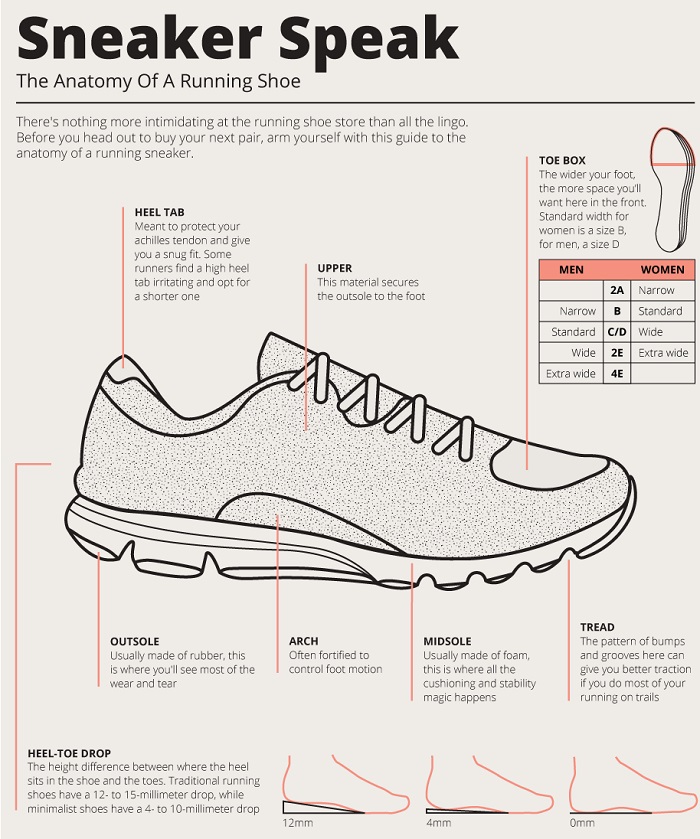
I forget we may not all know the lingo when talking about different components of the shoe and why they matter.
Cushioning
Brooks uses two types of cushioning in their designs:
- DNA LOFT – Soft cushioning, that adapts to a runner’s profile, stride, and speed
- BioMoGo DNA – also adapts to runner’s profile, stride, and speed, providing a more balanced experience with a bit of spring.
ASICS uses Flytefoam technology that provides bounceback and responsiveness with each step. It gives a bit less energy return than Brooks shoes, but the two technologies are fairly similar.
The company has been using their famous Gel technology for more than 30 years. It works well to absorb the shock with each step.
Stability
Brooks refers to individual running gaits as the “Run Signature.” Rather than “fix” the way someone runs, Brooks technology helps to stabilize your stride based on how you naturally run.
They put runners into two different categories: Neutral and Support.
Brooks GuideRails technology allows hips, knees, and joints to move naturally, offering support when needed. Neutral runners may only require them to kick in when their stride is off.
ASICS shoes provide stability through a dual density midsole system called Duomax, which enhances support and stability. That, along with the external heel clutch allow the foot to continue its natural movement while running.
Affordability
The prices between the two brands are fairly comparable. Brooks prices range between $100 to $160, while ASICS start at a slightly higher price at $110 to $160.
The most popular models for both brands are priced toward the higher range.
You’ll notice that every brand offers a range and this is indeed due to a difference in technology and where they sell the shoe. They know that the big box store can sell the shoe with less in it, while the local running store needs to be best for dedicated runners.
ASICS Vs Brooks Running Shoe Models
Now that you know more about each brand, let’s look at their top models in each of the main categories. There’s no winner declared here because all are great shoes, it’s just about which one is best for your foot.
Did you notice I even said the brands in reverse order this time…seriously no favorites, I have run in both brands many different times over the years.
Stability Running Shoe
👉ASICS GEL Kayano 29
The GEL Kayano is now in its 29th iteration and known as one of the best stability shoes on the market. Great for overpronators seeking stability, the GEL Kayano is an ideal shoe for marathons.
The heel and footbed are designed to provide maximum comfort and stability, which is great for longer distances. The uppers are lightweight, breathable, and durable, making them a great choice for running in any weather. The outsole provides good grip and traction on a variety of surfaces.
Overall, these are a great running shoe and I highly recommend them to anyone looking for a comfortable and supportive running shoe. There’s a reason this shoe is one of their top sellers.
- 10 mm drop
- 9.5 oz women’s, 10.5 oz men’s
- $160
- Available on Zappos, nearly every running store
- Read my in- depth review of the Kayano!
👉Brooks Adrenaline GTS 23
The brand’s most popular road running shoe (GTS stands for go-to-shoe) just turned 23 and comes in a swath of colors. This supportive shoe is best for a medium to high arch, and is part of the cushion line.
This was one of the very FIRST shoe brands that I bought at a running store! I thought it was so incredibly cool my name was on the shoe…ha!!! But yes they were super duper bright white (as you’ll see below). I also bought stability because I was told I needed it…but I’ve beaten this topic, many runners don’t.
This shoe does feel firmer, which is normal for a stability shoe with the guiderails that are trying to prevent your foot from falling inward.
It’s also a shoe I recommend for runners dealing with Plantar Fasciitis because it’s got a high arch and provides a lot of support.
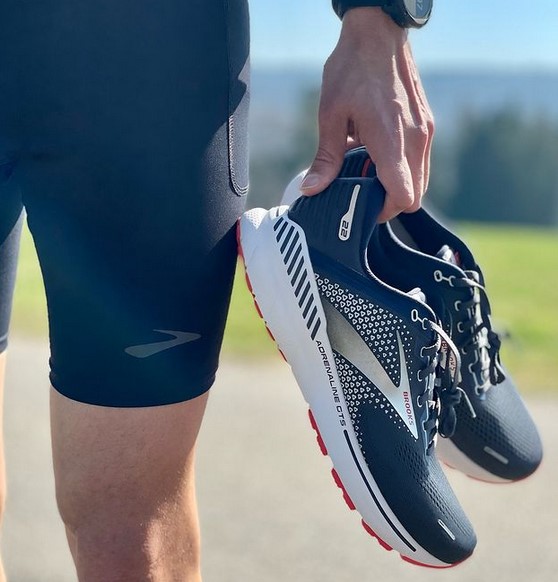
- 12 mm drop
- 8.9 oz women’s, 10.2 oz men’s
- $140
- Available on BrooksRunning.com and nearly every running store
The Brooks Adrenaline GTS is going to grow in popularity as Brooks got rid of it’s two other stability models the Ravena and Transcend. So it’s a good thing that it has many years of very happy runners behind it. It’s definitely a firmer daily trainer, to help provide that necessary support for overpronation.
Neutral Running Shoe
👉ASICS GEL Nimbus 26
This shoe will appeal to most runners looking for a neutral fit. The inclusion of ASICS technologies like the Flytefoam and the GEL offers cushioned support with a responsive fit. Whether you’re a casual runner or a hard core marathoner, this shoe is a great choice for a daily trainer.
I like the lower drop on this shoe for the majority of runners and find it’s right in the middle for cushion. Not too much to lose your step, but enough to still feel good.
If you’re looking for similar performance with a lighter environmental footprint, take a look at the GEL Nimbus Lite.
I struggled a little with how high the tongue and heel tags come up on this model, they just rubbed on my foot. But plenty of you have said that wasn’t an issue…so just something to consider!
- 8 mm drop
- 9.2 oz women’s, 10.5 oz men’s
- $160
- Available Amazon, Zappos, nearly every running store
- Read my full review of the Nimbus!
👉Brooks Ghost 15
The Ghost offers smooth transitions and soft cushioning for road running and is best for those seeking neutral support. Runners’ World has awarded this shoe several Editor’s Choice Awards.
I personally was so intrigued by those awards that I snagged myself a pair last year and they are nearing the end of their life, but have served me very, very well. Which is why I then upgraded to the newest model to see what might be different.
The heel-to-toe drop is a lot higher than I tend to like, but it’s a very standard traditional running shoe feel. So if you’re looking for that everyday run shoe, which can provide a moderate amount of cushion to go the distance, it’s a win.
- 12mm heel toe drop – again higher than I recommend for most runners, we see more overstriding and IT Band issues.’
- 10.1 oz for men’s, 9.1 oz for women’s
- $140
- Available on Brooksrunning.com
- Read my full review of the Brooks Ghost 15 >>
- Checkout this additional comparison of the Brooks Ghost Max and Glycerin >>
Cushioned Running Shoe
👉Asics Novablast 4
The Novablast has been a winning max cushion shoe from Asics since it first launched and they have continued to increase the amount of cushion in the shoe, while working to drop the weight.
This is in fact the most lightweight daily trainer on the list!
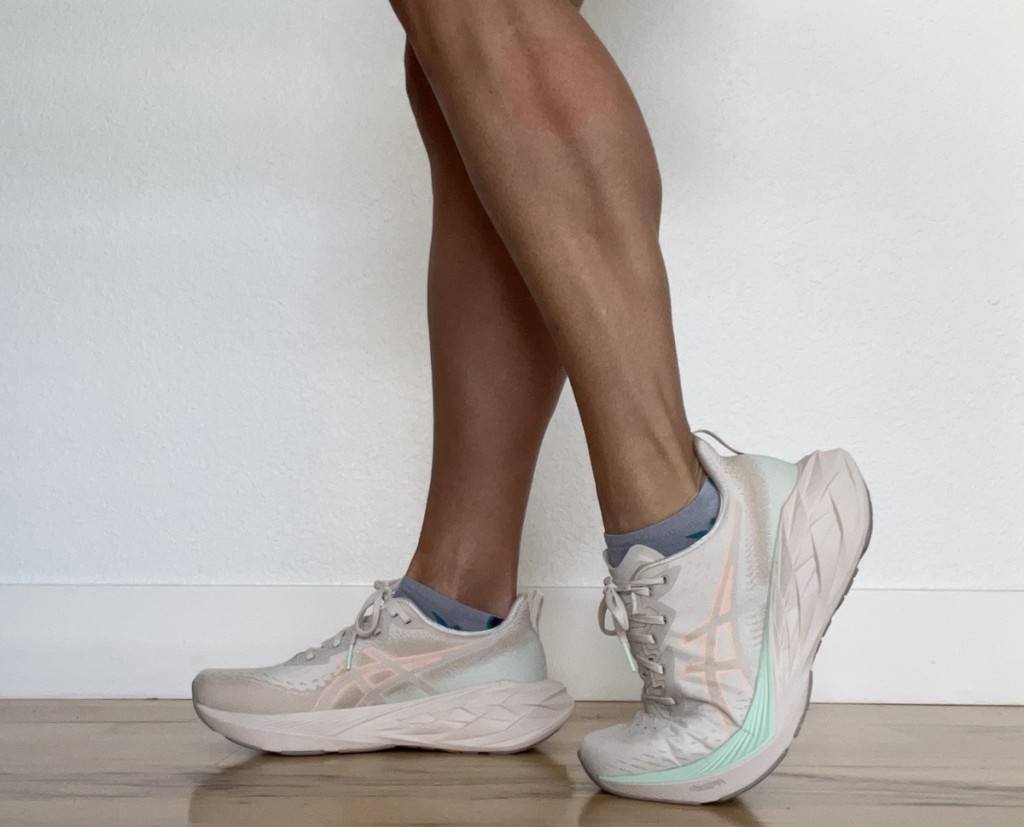
The midsole is Flytefoam Blast+ Eco, made from 20% bio-based materials to keep moving toward a goal of sustainability. For our purposes, what that means is it lives up to the name of MAX cushion! Again, I like that this shoe is a more responsive cushion and you don’t sink in to it so much.
While this is a neutral shoe, with no guiderails or anything for stability, it absolutely has some of that built in to the design. The width of the platform from toe to heel reduces pronation and provides a really good ride.
- 8mm drop
- 7.9 oz women’s, 9.1 oz men’s
- Available at Zappos $140 (my favorite for easy returns)
- Read my full review of the Asics Novablast 4 >>
👉Brooks Glycerin 21
It‘s a great all–around running shoe, providing great cushioning for a variety of running distances.
This is one of their shoes that also comes in a stability version, so if you see the GTS that’s what you’re getting. Having tested both, I definitely like this shoe but probably lean towards the Ghost as my preferred cushioned shoe for daily runs.
It’s got their new, Nitro -infused DNA loft which just makes it sound fast already. I feel like this shoe has gained some weight over the years as they try to enhance the cushion. So it used to be light and cushioned making it good for speed work or even marathon race day, but now I’d probably lean in to it as a daily trainer and look to some carbon fiber for race day.
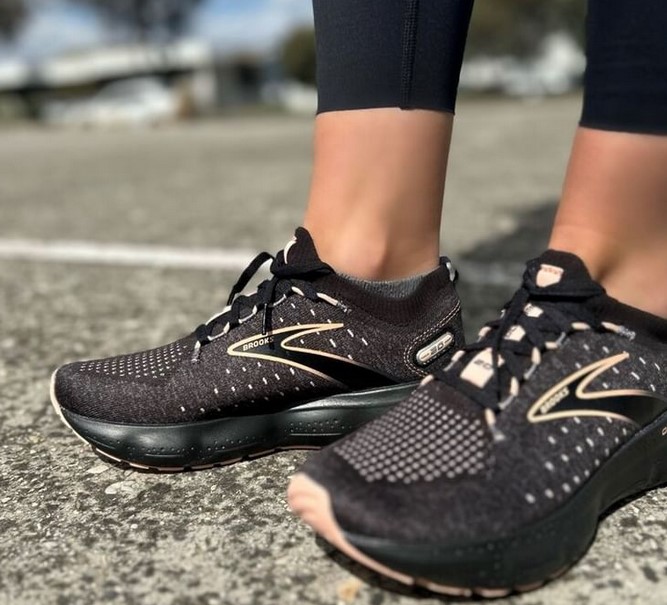
The upper is made from a breathable mesh material that keeps your feet cool and comfortable. The midsole offers great shock absorption, and the rubber sole provides reliable traction on a variety of surfaces.
- 10 mm heel drop
- 9.1 oz women’s, 10.3 oz men’s
- $140
Carbon Fiber Plate Shoes
Are they cool new technology, yes. Do they last as long as your other shoes, nope.
So if you want to test these out use them for speed work and then race day! Watch my detailed video on how Carbon Fiber Shoes work.
👉ASICS Metaspeed Sky
ASICS is trying to catch up in this area and released a few shoes all at once which many folks can’t quit tell apart. The Edge is going to be the shoe with less cushion, less weight and better for those racing sub 3, etc.
This is a maximum cushioned carbon fiber plate for the marathon runner in you. It’s going to give you both that feeling of comfort over the miles along with the pop that’s often lost in a highly cushioned shoe.
- Unisex in the SKY+
- 5 mm heel drop
- 5.8 oz women’s SKY, 7.2 oz SKY+
- $250
👉Brooks Hyperion Elite
Unlike many of the other carbon fiber shoes, Brooks says theirs could last up to 400 miles. That’s a pretty significant win for a carbon fiber shoe based on the price we’re all paying!
These are more of a maximal shoe with a higher stack height, which allows them to build in more cushion and their rapid roll technology. Which is a fancy way of saying the shoe should help some with a quick transition from heel to toe on each step.
Unfortunately the newest model also gained a few oz for them to put in more features. So…you’ll have to decide if it still feels as fast.
- Unisex
- 8 mm heel drop
- 7.8 oz
- $250
More About Brooks Running
Believe it or not, Brooks started out in 1914 making ballet slippers and bathing shoes. Since then, they have made everything from baseball and football cleats to roller skates.
It wasn’t until Frank Shorter won the marathon at the 1972 Munich Olympics that Brooks considered limiting its focus. The first running shoe debuted in 1974 and their most popular running shoe, the Adrenaline GTS first hit the market in 1999.
In 2001, Brooks decided to focus solely on running.
They introduced the Transcend in 2013, a shoe that used new biomechanics technology to create a GuideRails technology, allowing runners to run naturally without trying to correct their gait.
The Seattle-based company is also well known for its commitment to sustainability and giving back. Brooks donates time, gear, and money to companies that align with their values around diversity, equity, and inclusion and staff receive paid annual volunteer time.
More About ASICS
Founded in 1949, by Kihachiro Onitsuka in Japan, ASICS is an acronym for the Latin expression “Anima Sana in Corpore Sano” (“healthy mind in a healthy body”).
The company released a basketball shoe in 1950, followed by running shoes in 1953. Among those running shoe products included the Onitsuka Tiger, still a popular shoe today, though mainly used as a casual shoe as opposed to a marathon shoe.
Today, Asics designs a wide variety of shoes including: running, tennis, volleyball, wrestling, and golf.
Fun fact: Nike was founded to sell the Onitsuka Tiger shoes in the US. After visiting Japan in 1963, Phil Knight was impressed by the high quality and reasonable prices and asked the company to represent the brand in the US. Anyone else read his book and find all of this fascinating?!
How to Choose the Best Running Shoe?
ASICS and Brooks are the two most popular running shoe brands on the market, but more important than brand is the fit of the shoe.
Your gait and feet will likely change over time and you may need to change shoes.
This is also why I recommend rotating through several pairs of shoes at once.
And remember, just because these are two of the most well known brands on the market, there are still plenty of other shoe brands to select from if neither Brooks nor ASICS has the right shoe for you.
Keep in mind that shoe design can change, even with the same model, so always assess how the shoe fits every time you replace a pair.
For more help selecting the right shoe for you, don’t worry, I’ve got you:
- Best Trail Running Shoes
- Top 5 Marathon Running Shoes
- Skechers Running Shoes review (you might be surprised!)
- On Cloud vs Brooks
- Minimal or Maximal Running Shoes: Which is Right for You?
Other ways to connect with Amanda
Instagram Daily Fun: RunToTheFinish
Facebook Community Chatter: RunToTheFinish
Sign Up to Receive a Weekly Newsletter with Top Running Tips and Laughs
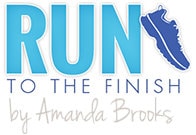

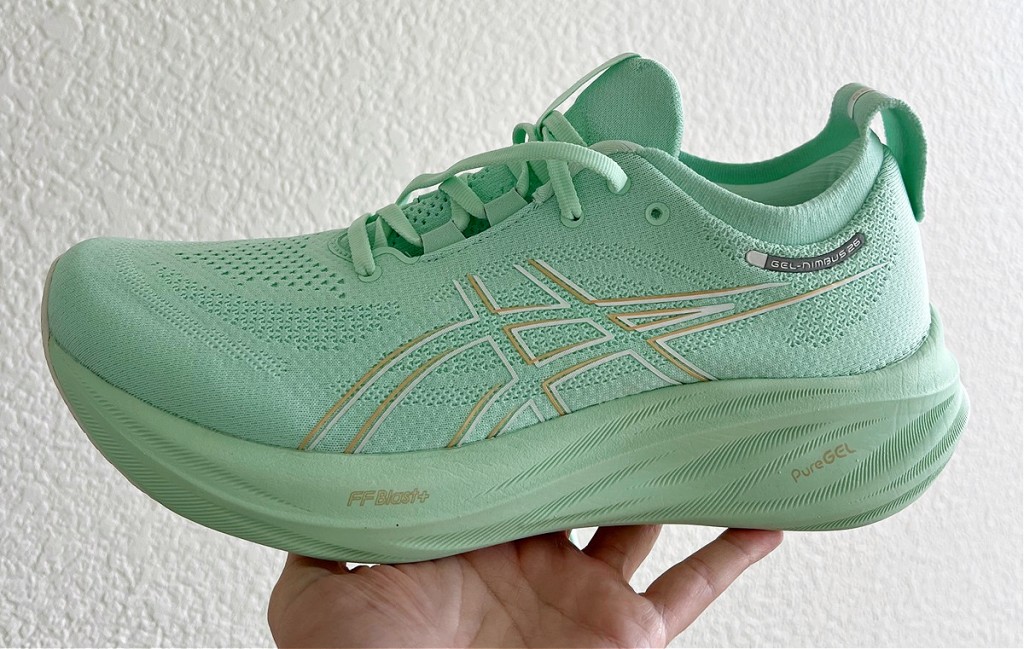
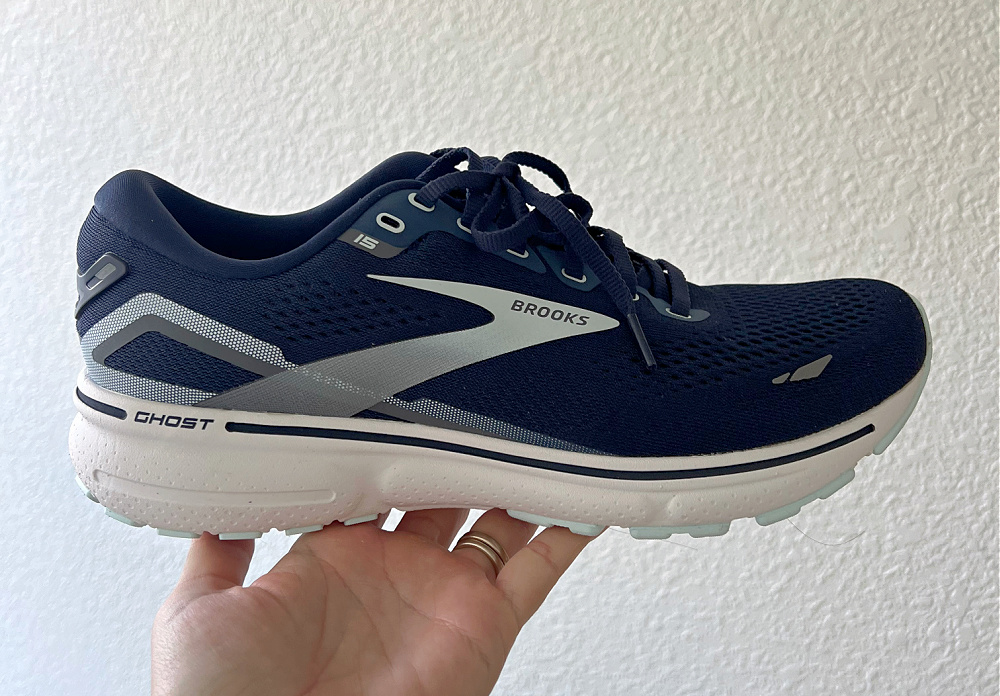
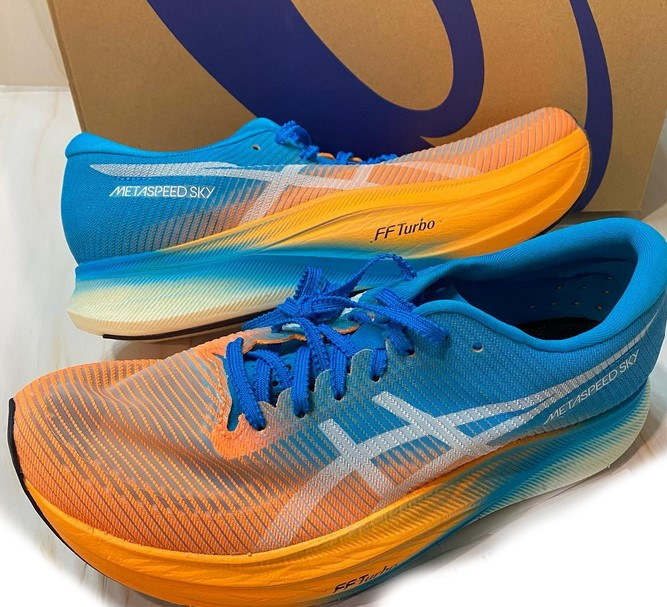
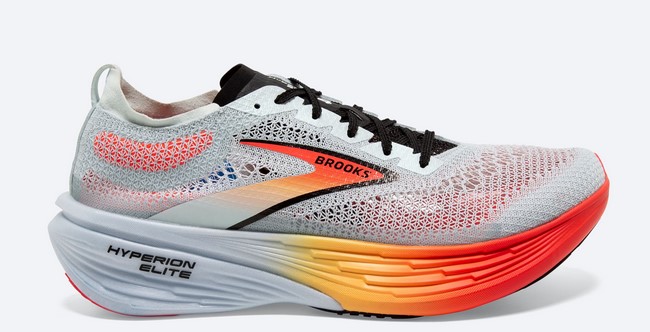
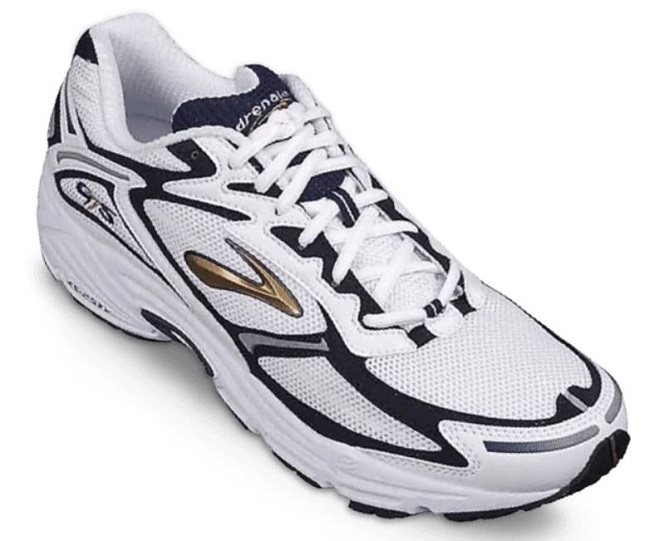
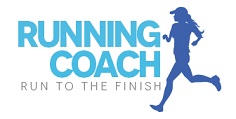
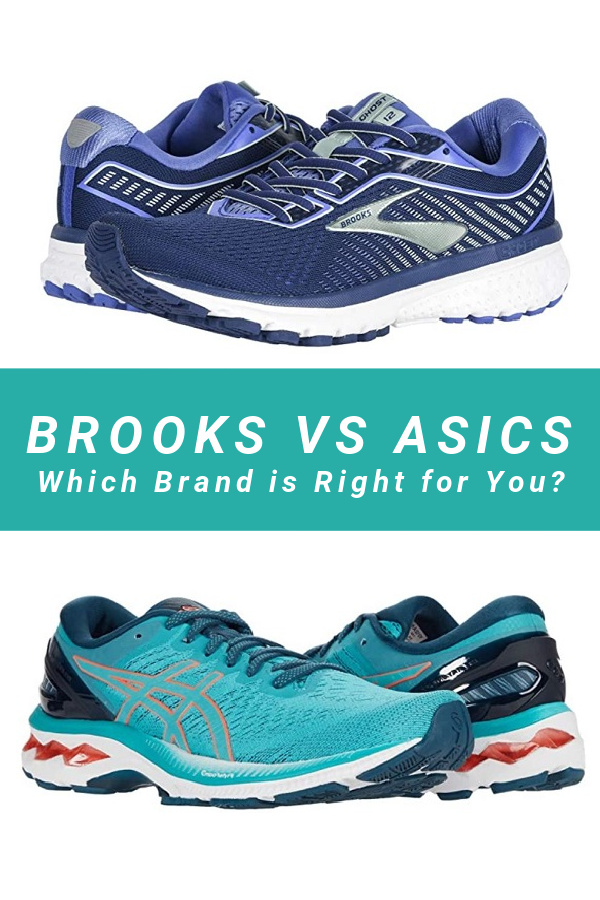
 Should I Run With Sore Legs? When to Go and When to Say No
Should I Run With Sore Legs? When to Go and When to Say No

Mike
I used to be 100% ASICS. Cumulus and Nimbus. But my big toe always made a hole after 100 miles or so. So I was retiring shoes early every time. So I tried Brooks Ghost and I can get over 400 miles with no issues. So I have switched completely now. All my ASICS are retired. And every pair had holes in the top on both feet.